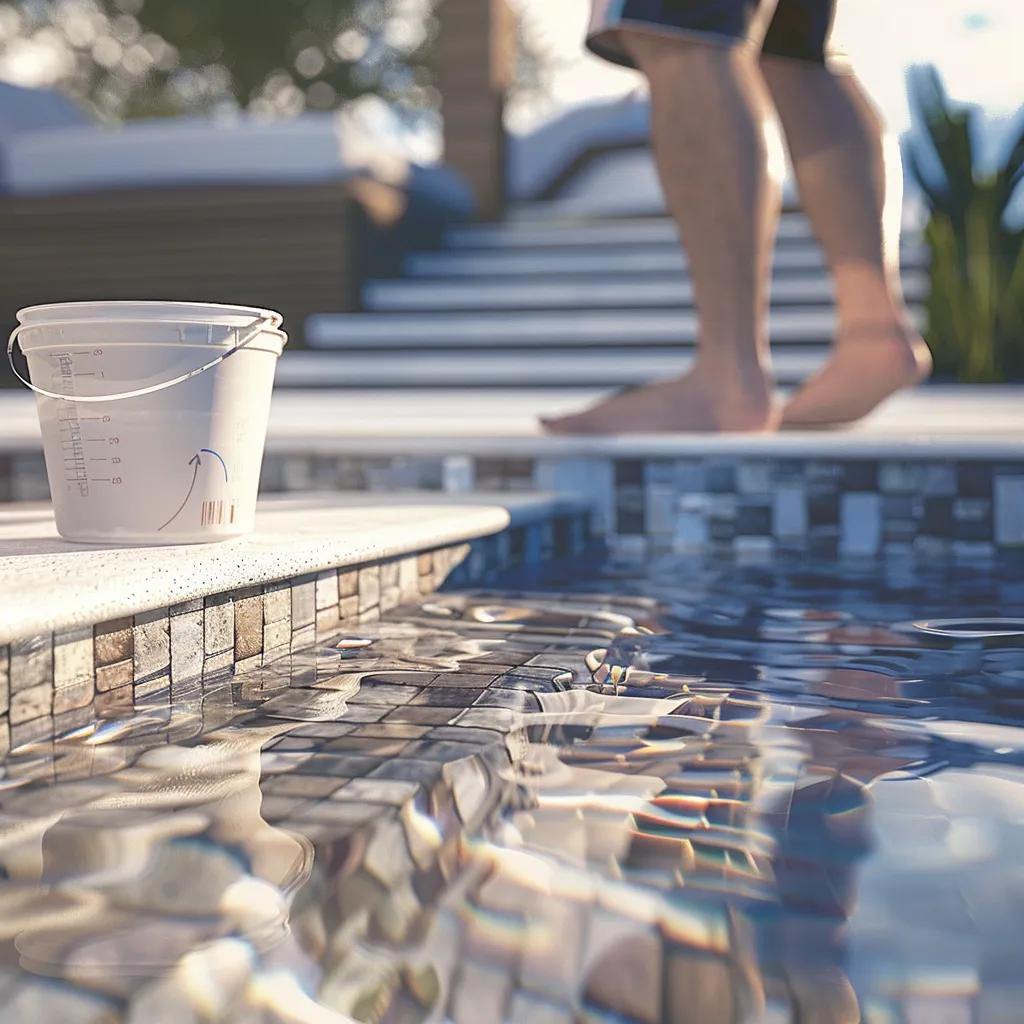Signs Your Pool Is Leaking – Pool Leak Detection in Orange County
Detecting a pool leak early can save thousands in water bills, structural damage, and chemical imbalance. When it comes to pool leak detection in Orange County—even a small crack or loose fitting can spiral into major issues—so understanding signs of a leaking pool is essential. This guide covers how to distinguish evaporation from leaks, recognize visual and equipment indicators, perform DIY tests, know when to call Suncoast Pool & Spa, and prevent future leaks.
You’ll learn:
- How to tell if water loss is normal evaporation or a true leak
- Visual and mechanical warning signs to watch for
- DIY detection methods before bringing in professionals
- When and why Suncoast Pool & Spa’s leak detection and repair services are your best choice
- Maintenance tips to keep your pool watertight long-term
How Can You Tell If Your Pool Is Leaking Beyond Normal Evaporation?
Pool water loss can result from natural evaporation or a leaking structure, plumbing, or equipment. Understanding both processes helps you decide when to intervene and protect your investment.
What Is Normal Evaporation and How Much Water Loss Is Expected?
Normal evaporation depends on temperature, humidity, wind, and solar exposure. In Southern California, a well-maintained pool typically loses 1/8 to 1/4 inch of water per day. Anything beyond that range signals a potential leak, especially if you haven’t adjusted for environmental factors or run your pump and filter regularly.
This baseline leads us to a simple confirmation method: the bucket test.
Understanding Pool Water Loss
Normal evaporation rates for pools are influenced by several factors, including temperature, humidity, wind, and sun exposure. In Southern California, a typical well-maintained pool may lose between 1/8 to 1/4 inch of water per day due to evaporation. This baseline is crucial for distinguishing normal water loss from a potential leak.
National Swimming Pool Foundation, The Certified Pool & Spa Operator Handbook (2017)
How to Perform the Bucket Test to Confirm a Pool Leak

- Place a five-gallon bucket on the second pool step and fill it halfway with water.
- Mark the water level inside the bucket and on the pool wall at the same height.
- Run the pump for 24 hours without adding water to the pool.
- Compare water loss in the bucket vs. the pool.
- If the pool level drops more than the bucket, you likely have a leak.
- If both levels drop equally, water loss is due to evaporation.
A clear bucket test result guides your next steps in pinpointing and fixing leaks.
The Bucket Test for Leak Detection
The bucket test is a reliable method for distinguishing between water loss due to evaporation and water loss due to a leak. By comparing the water level drop in a bucket placed in the pool with the water level drop in the pool itself over a 24-hour period, one can determine if a leak is present.
Association of Pool & Spa Professionals, Pool & Spa Water Chemistry (2019)
What Are the Early Signs of Unexplained Water Loss in Pools?
Even before measurements, some clues hint at a hidden leak:
- Rapid daily drop in water level (>¼ inch)
- Constant autofill valve activation without heavy use
- Visible drip or moisture at the waterline fittings
- Excessive chemical consumption to maintain sanitizer levels
What Visual Signs Indicate Your Pool Might Be Leaking?
Leaks often manifest in visible symptoms on the pool shell, deck, and surrounding ground. Regular inspections help you spot issues before they worsen.
How Do Cracks and Gaps in Pool Plaster, Tile, or Deck Signal Leaks?
Structural cracks and gaps allow water to migrate beyond the shell, undermining pool integrity. Plaster separation, grout cracks, or deck fissures often correspond with slow water seepage that weakens the substrate.
| Entity | Attribute | Value |
|---|---|---|
| Plaster | Surface Cracks | Hairline to ¼” fissures allowing seepage |
| Tile Grout | Separation | Gaps at tile edges indicating water intrusion |
| Deck Slab | Concrete Gaps | ½” or larger fissures near waterline |
Why Are Wet Spots or Mushy Ground Around Your Pool a Warning Sign?
Soil saturation or unexplained damp patches adjacent to the pool deck typically indicate underground plumbing leaks. Moist ground under decks, soggy grass, or sinkage near return lines show water escaping beneath the surface. Early detection stops soil erosion that could destabilize pool walls and decking.
How Does Persistent Algae Growth or Chemical Imbalance Relate to Leaks?
Uncontrolled algae blooms and erratic chemical readings often follow a leak that dilutes sanitizer, introduces fresh water, or flushes chemicals. A leaking return line or skimmer inlet can draw in nutrient-rich water, fueling algae. Consistent chemical imbalance despite regular maintenance suggests hidden water exchange with the surrounding soil.
What Equipment and Plumbing Issues Reveal Pool Leaks?
Beyond visual cues, mechanical systems can betray a leak’s presence through unusual behavior or added strain.
How Do High Water Bills and Constantly Running Autofill Indicate a Leak?
An unnoticed leak drives up municipal water usage and bills. When autofill valves run continuously to maintain pool level, they mask steady water loss while erasing visible surface drop-offs. Monitoring your water statement alongside autofill activity reveals discrepancies pointing to leaks.
What Does Water Under Pool Equipment or Air Bubbles in the Pump Mean?
Pooling water beneath the pump, filter, or heater often comes from a failing seal or cracked plumbing fitting. Air bubbles in return lines also suggest suction leaks—where air enters through cracks in skimmer lines or loose pump unions. These symptoms signal equipment-related leaks requiring prompt attention.
How Can Pool Pump, Skimmer, and Plumbing Leaks Be Identified?
A systematic check of mechanical components uncovers common leak points:
- Inspect pump lid o-rings and seal plate for moisture.
- Examine skimmer box for cracks, loose bolts, or deteriorated gaskets.
- Trace return and suction lines with a pressure gauge.
- Use acoustic listening devices on buried pipes.
How Can You Detect Pool Leaks Yourself Before Calling a Professional?
DIY methods can reveal many leaks, but some underground or complex leaks require specialized tools.
What Is the Dye Test and How Does It Help Locate Pool Leaks?
The dye test injects colored fluid near suspected leak areas (cracks, fittings, light niches). Dye will be drawn into any opening, visually pinpointing water escape routes. This method requires calm waters and close observation but provides accurate leak mapping before excavation.
How to Conduct a Visual Inspection for Pool Leak Signs
A thorough visual sweep involves:
- Checking all pool surfaces in daylight for plaster or liner tears.
- Examining tile grout lines and light niches for gaps.
- Surveying deck joints and expansion cracks for moisture.
- Monitoring pump strainer baskets and filter pressure trends.
A comprehensive visual audit guides you toward potential leak zones and clarifies whether professional intervention is needed.
When Is the Bucket Test Not Enough to Detect Hidden Leaks?
The bucket test fails to detect subsurface, plumbing, or equipment leaks that don’t affect surface evaporation rates. Underground pipe breaks, deep liner punctures, or hairline shell fractures require pressure testing, acoustic detectors, or professional infrared scanning to locate.
When Should You Call for Professional Pool Leak Detection in Orange County?
Complex leaks beneath slabs, within plumbing, or in structural components often need expert intervention. Calling a professional at the right time prevents further property damage and water loss.
Benefits of Professional Pool Leak Detection Services in Orange County
Professional detection services leverage non-invasive techniques—acoustic listening, pressure testing, video pipe inspection—that pinpoint leaks without extensive excavation. Expert equipment and trained technicians ensure accurate diagnosis, faster turnaround, and cost savings over trial-and-error repairs.
Professional Leak Detection Services
Professional leak detection services utilize advanced techniques such as acoustic listening, pressure testing, and video pipe inspection to pinpoint leaks without extensive excavation. These methods ensure accurate diagnosis and can lead to cost savings compared to trial-and-error repairs.
International Association of Certified Home Inspectors, Standards of Practice for Performing Pool Inspections
How Sun Coast Pools & Spa Handles Pool Leak Detection & Repairs in Orange County
Suncoast Pool & Spa’s technicians use advanced acoustic sensors and hydrostatic pressure tests to locate leaks under decks and within buried plumbing. After mapping the leak, they deploy targeted excavation or trenchless repair methods, restoring pool integrity with minimal disruption to landscaping and pool use.
What Is the Typical Cost Range for Pool Leak Repair in Southern California?
Pools vary in construction and leak complexity, but average repair costs follow this range:
| Repair Type | Typical Cost Range | Influencing Factors |
|---|---|---|
| Simple Plaster or Tile Crack | $150 – $500 | Crack size, access, material matching |
| Equipment/Seal Replacement | $300 – $1,000 | Part complexity, labor, system downtime |
| Underground Pipe Repair | $800 – $2,500 | Depth, pipe type, trenching requirements |
| Structural Shell Leak Repair | $1,500 – $5,000+ | Shell type, excavation, waterproofing, deck restoration |
How Can You Prevent Pool Leaks and Maintain Pool Integrity Long-Term?
Regular maintenance and proactive inspections reduce leak risk and preserve pool value.
What Pool Maintenance Tips Help Avoid Leaks?

Implement a routine care regimen that includes:
- Balanced Water Chemistry – prevents corrosion of liners and metal fittings
- Monthly Surface Inspections – identify small cracks before they enlarge
- Seasonal Equipment Checkups – replace worn seals, gaskets, and o-rings
- Proper Winterization – avoid freeze damage to plumbing and shell
How to Differentiate Between Evaporation and Leak-Related Water Loss Over Time
Track daily water levels at the same time, noting environmental conditions. Reapply the bucket test monthly and compare loss patterns. Evaporation remains consistent; leaks accelerate loss unpredictably, especially after equipment cycles or rain events that should naturally reset water levels.
What Are Common Causes of Pool Leaks in Southern California’s Climate?
Local factors accelerate wear and stress on pool systems:
- Soil Settlement – expands and contracts with drought and irrigation
- UV Degradation – weakens liners and surface coatings under intense sun
- Hard Water Scaling – stresses seals and grout joints
- Seismic Shifts – small tremors can open shell fissures
What Are the Most Frequently Asked Questions About Pool Leaks?
Homeowners often seek clarity on leak vs. evaporation, detection techniques, costs, and DIY viability. Below are concise, direct answers to these common concerns.
How Do I Know If My Pool Is Leaking or Just Losing Water to Evaporation?
If water loss exceeds 1/4 inch per day after accounting for wind and sun exposure, it signals a leak rather than evaporation. A bucket test confirms by isolating evaporation—when the pool level drops more than the bucket, you have a leak.
How Do You Find a Small or Hidden Leak in a Pool?
Begin with a dye test around fittings, cracks, and light niches. If dye fails to reveal leaks, professionals use pressure testing on plumbing lines and acoustic detection to locate subsurface and equipment leaks.
What Is the Average Cost to Fix a Pool Leak?
Southern California repair costs range from $150 for simple surface cracks to over $5,000 for complex structural or underground pipe leaks. Factors include leak location, access difficulty, materials, and required excavation.
Can I Repair a Pool Leak Myself or Should I Hire a Professional?
Minor vinyl liner punctures or small plaster cracks can be patched with home kits. However, leaks in plumbing, buried pipes, and structural shell integrity require professional tools and expertise for a lasting repair.
Early leak detection and timely repairs preserve water, chemistry balance, and pool structure. If you suspect your pool may be losing water, don’t wait — professional pool leak detection in Orange County ensures accurate diagnosis and long-lasting repairs. Sun Coast Pools & Spa uses advanced technology to locate hidden leaks and restore your pool quickly and efficiently. Call our Orange County team today to schedule a leak inspection and keep your pool watertight, safe, and worry-free.
Why Choose Sun Coast Pools & Spa for Pool Leak Detection in Orange County?
From advanced acoustic testing to targeted repairs, Sun Coast Pools & Spa specializes in accurate, non-invasive leak detection that saves time, money, and water for Orange County pool owners.

